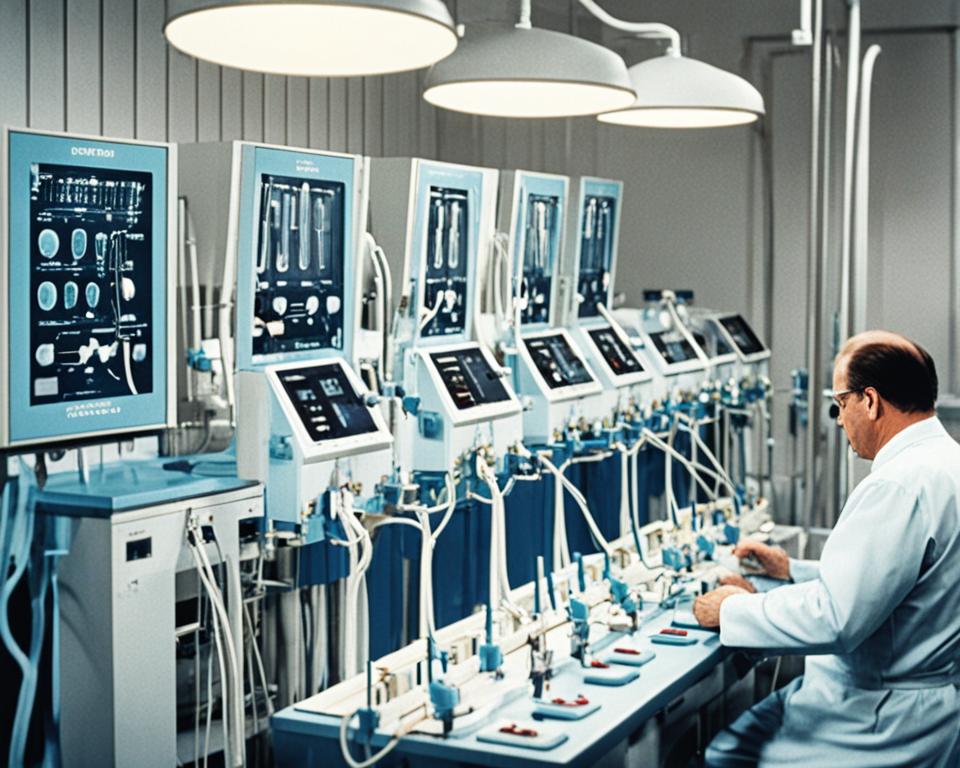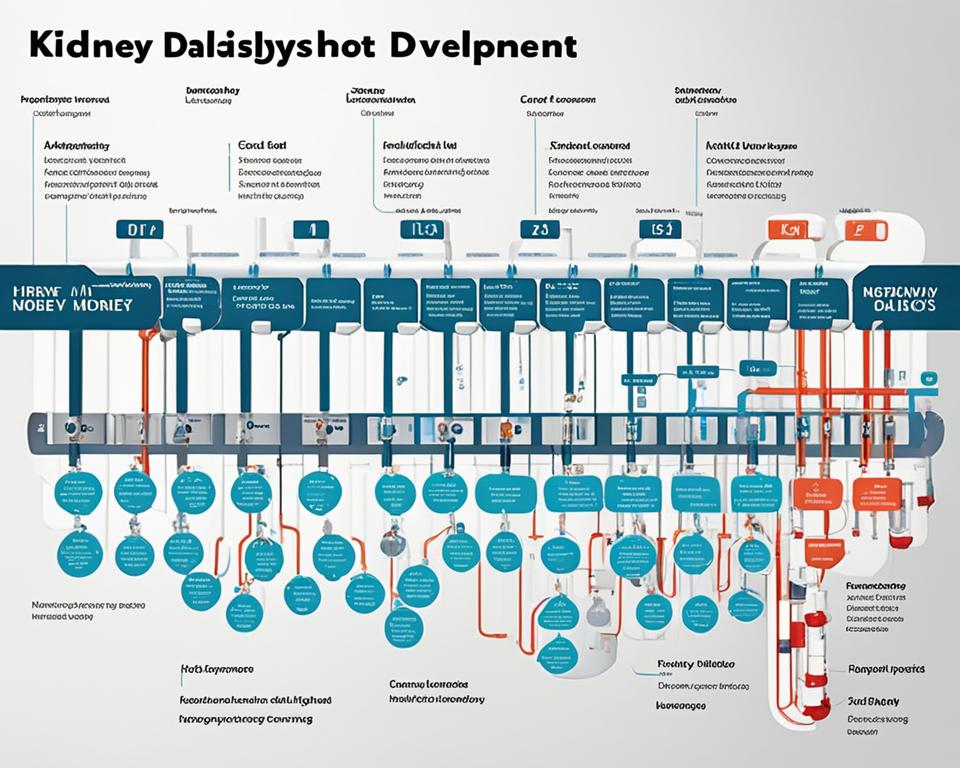Who Invented Kidney Dialysis? A Medical Breakthrough

The development of kidney dialysis is an incredible story of overcoming challenges. It all started with Willem Kolff’s pioneering efforts. In 1943, the Dutch doctor built the first successful dialysis machine. This invention marked a new era in saving lives for people suffering from kidney failure.
Kidney dialysis allows the blood to be cleaned when the kidneys can’t do it themselves. Today, it is a vital treatment for millions around the globe. The path to this solution was full of innovation and sheer determination. This piece looks back at the start of dialysis, honouring the early experts in nephrology. Their work inspired Kolff’s and led to the advancements we see in today’s dialysis care.
Read interesting things at : intarajyuku
Key Takeaways
- Kidney dialysis was invented by Dutch physician Willem Kolff in 1943, a groundbreaking development in the treatment of kidney failure.
- Kolff’s pioneering work built upon the efforts of other nephrology researchers who had been exploring ways to artificially support kidney function.
- The Kolff rotating drum dialyzer, the first successful dialysis machine, revolutionized the treatment of end-stage renal disease and saved countless lives.
- The evolution of hemodialysis techniques and the development of innovative dialysis equipment have continued to improve the quality of life for patients with kidney disease.
- The story of kidney dialysis is a testament to the power of medical innovation and the dedication of healthcare professionals to find solutions to complex medical challenges.
The Origins of Kidney Dialysis
Kidney dialysis started with the work of key people in nephrology. It began as an idea and grew into a life-saving treatment. These scientists and researchers learned about the human kidney. Their work changed how we treat kidney failure.
Trailblazers in Nephrology
Richard Bright stood out in the 1820s. He advanced our knowledge of kidney diseases. His findings helped others learn more and do new things.
Thomas Addis also did a lot. He studied what the kidney does at the chemical level. Addis’s research early on made ways for understanding how the kidneys work. This is important for how we treat them today.
Early Attempts at Artificial Kidney Support
Doctors and scientists began trying to help the kidney work artificially. In the 1800s and 1900s, John Abel, Georg Haas, and Willem Kolff tried to build devices. These would act like kidneys by cleaning blood.
Although their first tries faced many problems, they were key. These early tries helped make successful kidney treatments happen later. The hard work of these early pioneers led to big changes. They made the care for people with kidney failure much better.
Willem Kolff: The Father of Dialysis
Dr. Willem Kolff stands out in medical history as the “Father of Dialysis.” He was a Dutch physician. Kolff’s work with kidney dialysis saved many lives and greatly changed kidney disease treatment.
In the 1930s, Kolff started his path as the artificial kidney inventor. He was a young student in the Netherlands. Kolff focused on making the first working dialysis machine, the Kolff Rotating Drum Dialyzer.
Creating an artificial kidney had its tough moments for Kolff. He met many challenges and even failure. Yet, his determination always stayed strong. In 1943, after years of trying, he successfully used his machine to treat a patient for the first time.
Kolff’s work in kidney dialysis history changed everything. He introduced the world to dialysis. Today, dialysis is a common and critical treatment for kidney failure around the globe. His Kolff Rotating Drum Dialyzer method is still used in dialysis centers everywhere.
Kolff’s title as the “Father of Dialysis” goes beyond his invention. He was also a big proponent for better kidney disease care. His dedication and intelligence made a lasting mark in medicine. Willem Kolff is remembered as one of the top dialysis pioneers ever.
“The development of the artificial kidney was one of the most important medical achievements of the 20th century. It has saved the lives of hundreds of thousands of people.”
– Willem Kolff
The Kolff Rotating Drum Dialyzer
Dutch physician Willem Kolff created the Kolff Rotating Drum Dialyzer. This machine was a game-changer for dialysis, the key technology for kidney treatment today. He is called the “father of dialysis” for his role. His device aimed to cleanse the blood of kidney disease patients, a crucial task.
Principle and Design of the Pioneering Machine
Kolff’s machine worked on the concept of hemodialysis. In this process, the blood of the patient passes through a filter. This filter, made of a special material, removes waste and extra fluid from the blood. Kolff’s design included a drum that could move. It was partially in a solution, and patient blood passed through it.
The process worked as the drum turned. Because it turned, it allowed the blood and the cleansing solution to meet and switch with each other. This way, harmful waste like urea left the blood. Such a creative method was a big step forward in hemodialysis. It created a path for making kidney dialysis better and better.
| Key Features of the Kolff Rotating Drum Dialyzer | Description |
|---|---|
| Rotating Drum | The drum, partially submerged in a dialysis solution, rotated to facilitate the exchange of molecules between the blood and the solution. |
| Coiled Tubing | The patient’s blood flowed through a series of coiled tubes within the rotating drum, allowing for effective filtration. |
| Semiperme able Membrane | The membrane used in the device was designed to selectively allow the passage of waste products and excess fluid, while retaining essential blood components. |
| Dialysis Solution | The dialysis solution, or “dialysate,” was carefully formulated to facilitate the removal of unwanted substances from the blood. |
The willem kolff dialysis machine changed the game in artificial kidney work. His design ushered in a new era in treating kidney sickness.
“The Kolff Rotating Drum Dialyzer was a pivotal invention that paved the way for the widespread adoption of kidney dialysis, ultimately saving countless lives.”
The First Successful Dialysis Treatment
The start of kidney dialysis history had a big moment in the 1940s. A dialysis machine by Willem Kolff was first used successfully. It was used to help a patient with kidney failure survive. This event was a turning point, opening door for kidney dialysis history and kidney failure treatment history.
By 1945, Kolff’s machine was used on a woman, Susanne Giesen, who needed it. She was 67 and very sick from her kidneys. Despite earlier efforts failing, Kolff’s creation saved her life. This was a big step in the dialysis treatment origins, showing that dialysis could really help. Susanne got better after her first session.
This success changed kidney treatment forever. Kolff’s work showed dialysis could save people. After saving Susanne, he and his team kept making the machine better. This led to more widespread use, making dialysis a key treatment for people with kidney failure.
“The first successful dialysis treatment was a pivotal moment in the history of dialysis, paving the way for the development of this life-saving technology.”
The first dialysis victory also made people see we need more to help others. Researchers and doctors started working even harder to solve dialysis challenges. These included how to keep the blood thin, how to safely reach the patient’s blood, and how to make treatment last longer.
Kolff’s early work and its success set the stage for amazing growth in dialysis. This special moment was the start of better ways to treat kidney dialysis history and kidney failure treatment history. It saved many lives and changed how we care for people with kidney disease.
Overcoming Challenges in Dialysis Development
Kidney dialysis technology faced many challenges during its development. Early pioneers such as Willem Kolff worked hard to improve the dialysis process. Using heparin, a strong anticoagulant, was a major breakthrough. It helped dialysis become more widely used.
Heparin and Anticoagulation Breakthroughs
In the early days of dialysis, blood clotting was a big problem. The artificial kidney would often get clogged as the patient’s blood flowed through it. This issue needed to be fixed for dialysis to be a reliable treatment.
Then, researchers discovered heparin. Heparin stops blood from clotting. Kolff and his team found that using heparin in dialysis helped prevent blood from clogging the machine. This made the treatment much better.
Adding heparin to the dialysis process was a key breakthrough. It, along with other advances in preventing blood clots, made dialysis more effective. This was good news for people with kidney failure.
| Year | Breakthrough | Impact |
|---|---|---|
| 1916 | Discovery of Heparin | Enabled anticoagulation during dialysis, reducing clotting and improving treatment outcomes. |
| 1940s | Development of Continuous Anticoagulation | Allowed for longer dialysis sessions and more efficient blood purification. |
| 1960s | Introduction of Disposable Dialyzers | Improved sterility and reduced the risk of infection during dialysis. |
These breakthroughs in anticoagulation were vital. They helped the pioneers of hemodialysis overcome early challenges. This paved the way for dialysis to be adopted widely. It also led to continual improvements in this important treatment.
The Evolution of Hemodialysis Techniques
The story of hemodialysis development began with Willem Kolff’s work in the 1940s. His first rotating drum dialyzer started it all. Since then, the kidney dialysis innovation has kept evolving. Nephrologists and medical engineers work hard to improve patient results and the kidney failure treatment history.
The 1960s saw a key change with the coil dialyzer. It replaced the bulky rotating drum with a sleek coil-shaped membrane. This new design offered more surface area and better diffusion. It opened the door for compact, portable dialysis machines, making care more convenient for patients.
In the 1970s, hollow-fiber dialyzers were a big leap forward. They featured membranes made of a bundle of tiny fibers. This design offered even more surface area for better filtration and waste removal. Hollow-fiber dialyzers, along with new anticoagulation methods, improved the safety and success of dialysis.
| Year | Hemodialysis Technique | Key Advancement |
|---|---|---|
| 1940s | Rotating Drum Dialyzer | Kolff’s pioneering work |
| 1960s | Coil Dialyzer | Improved surface area and portability |
| 1970s | Hollow-Fiber Dialyzer | Enhanced filtration and safety |
The journey of hemodialysis doesn’t stop. Hi-tech high-flux dialyzers, machines that adjust by feedback, and better blood-flow monitors have come in. These updates have made dialysis more efficient and cozy. They cut down on problems and boost the life quality for people with kidney failure.

As nephrology keeps getting better, so will kidney dialysis innovation. Always aiming for superior outcomes and patient experiences. The kidney failure treatment history shows the amazing work of those who laid the foundation for today’s hemodialysis techniques.
Kidney Dialysis Innovations and Advancements
Kidney dialysis has seen huge improvements over time, now saving more lives than ever before. Innovations like disposable filters and smaller machines have made it easier to get treatment. These changes have been a big help to people needing this medical support.
Disposable Dialyzers and Portable Machines
The introduction of disposable dialyzers was a big step forward. Before, dialysis required big, multi-use machines. Now, with disposable filters, the process is cleaner and simpler. This innovation means less chance of spreading germs and quicker treatments for patients.
Portable dialysis machines have also changed how treatment works. Patients can now do dialysis at home or on the go. This has improved their daily life and freedom quite a bit.
| Innovation | Impact |
|---|---|
| Disposable Dialyzers | Improved hygiene, faster and more efficient treatments |
| Portable Dialysis Machines | Increased patient independence and quality of life |
These advancements have made a big difference in kidney dialysis treatment. They’ve not only helped patients handle their condition better. They also mark a step forward in how we approach kidney failure.
“Disposable filters and portable machines have changed the game in kidney dialysis. They let patients take control and have made a huge difference in treatment delivery.”
The Impact of Dialysis on Kidney Disease Treatment
The invention of kidney dialysis changed the game for treating kidney disease. It became a life-saving tool for many facing kidney failure. It let them steer their health and live a more engaged life.
Before dialysis, a kidney failure diagnosis often meant the worst. With very few ways to cope, most patients didn’t have a bright future. But, the efforts of key figures like Willem Kolff revamped how we deal with kidney problems, saving many lives.
Dialysis changed the approach to handling kidney disease, giving patients a chance to clear out waste and extra fluids. This has boosted the life quality for folks with kidney failure. They can be more independent and dive back into their usual daily routines.
The kidney failure treatment history has been truly transformed by dialysis. Its impact goes beyond just prolonging lives. It also lit the way for leaps in nephrology and transplant care. The dialysis treatment origins can be credited to the relentless work of many medical minds.
The story of kidney dialysis history keeps evolving, with new tech and better care in hemodialysis and peritoneal dialysis. This means there’s real hope ahead for those battling kidney issues. Dialysis’s game-changing role will surely echo through the years to come.
| Milestone | Year | Impact |
|---|---|---|
| First successful dialysis treatment | 1945 | Demonstrated the feasibility of dialysis as a life-saving treatment for kidney failure |
| Development of the Kolff Rotating Drum Dialyzer | 1943 | Pioneered the design of the first practical and reliable dialysis machine |
| Breakthrough in anticoagulation for dialysis | 1950s | Enabled safer and more effective dialysis treatments by preventing blood clots |
| Introduction of disposable dialyzers | 1960s | Improved efficiency, safety, and accessibility of dialysis for patients |
“Dialysis has given millions of people a second chance at life, allowing them to manage their kidney disease and live fuller, more active lives.”
Dialysis has huge effects on kidney care, offering millions a new lease on life. It’s a vital step for better health and living well. With kidney dialysis history still progressing, the future looks bright for those with kidney disease challenges.
who invented kidney dialysis
Kidney dialysis began with the work of Dutch doctor Willem Kolff. He wanted to help people with failing kidneys. In the 1940s, he made the first dialysis machine. This was a huge step forward in treating kidney problems.
In the Netherlands, 1911, Kolff saw the need for blood filtering. He started to design a machine for it in the 1930s. His experiences with sick kidney patients inspired him.
- Kolff’s first attempts used items like sausage casings. He wanted to create a machine to clean the blood. But these tries did not work well at first.
- Kolff kept improving his machine. He developed the “Kolff Rotating Drum Dialyzer.” This device used a rotating drum to clean the blood.
- After many years of hard work, Kolff treated his first patient in 1945. It was a big achievement in treating kidney diseases.
His machine opened the door for using dialysis in kidney care. Kolff’s efforts saved many lives. He also pushed forward research in dialysis and kidney health.
“The artificial kidney was the first successful application of an external organ to replace the function of a diseased internal organ.”
Today, Kolff’s work is key in helping those with kidney issues worldwide. His invention is a vital part of medical care.

Dialysis Pioneers and Their Contributions
Many people worked together for years to develop kidney dialysis. Though often called the “father of dialysis,” Willem Kolff, others also greatly helped. They all added to the breakthrough of saving lives with this medical process.
Recognizing the Pioneers of Dialysis
Besides Kolff’s role, numerous researchers, scientists, and doctors were critical to dialysis and nephrology’s progress. Dialysis pioneers like these put their hearts into making the technology better. They made dialysis safer and helped patients more.
American doctor George Schreiner improved the design of the rotating drum dialyzer with Kolff. This change boosted dialysis’s effectiveness and safety. It made it possible for more people to benefit from the treatment.
Swedish doctor Nils Alwall introduced an upgraded artificial kidney in the 1940s. His improvements, like the flat plate dialyzer, played a huge part in kidney dialysis history. They advanced hemodialysis development.
Italian doctor Belding Scribner is also key for inventing the Scribner shunt. This device allowed for easier, repeated dialysis treatments. It greatly bettered the lives of those with severe kidney issues.
| Dialysis Pioneer | Contribution |
|---|---|
| George Schreiner | Collaborated with Kolff to improve the rotating drum dialyzer design |
| Nils Alwall | Developed an improved version of the artificial kidney in the late 1940s |
| Belding Scribner | Invented the Scribner shunt, enabling long-term vascular access for dialysis patients |
These pioneers are some of many who have made kidney dialysis what it is today. Without their hard work, dialysis wouldn’t be the effective, life-saving treatment it is. We owe them a lot for their dedication to helping others with kidney failure.
Ethical Considerations in Dialysis Development
The development of kidney dialysis was a huge step in medicine. Yet, it brought up important ethical questions. As dialysis became more common, making sure everyone who needed it could get it was a big challenge.
Getting more dialysis machines and trained workers was not easy. Choosing who should get treated first was hard. They had to look at things like how sick someone was and their chance of getting better. This made people talk a lot about what was fair and right.
A lot was also said about making dialysis available to everyone. Things like where someone lived, if they had insurance, or how much money they had could stop them from getting dialysis. Many people who needed help the most couldn’t get it.
As dialysis tech got better, making sure patients knew what they were getting into was vital. They should understand what dialysis could and couldn’t do for them. The goal was to help patients make smart choices about their own health.
“The ethical dilemmas in dialysis development serve as a reminder that medical progress must be balanced with a deep consideration for the well-being and rights of the patients it aims to serve.”
This journey in kidney dialysis is still full of challenges. Health workers, leaders, and people who stand up for patients all need to work together. Keeping an eye on ethics is key. It ensures that everyone who faces kidney failure can truly benefit.
Future Directions in Kidney Dialysis Technology
The world of kidney dialysis is changing fast. New tech and ideas are coming up, promising a different future for this vital treatment. Scientists and doctors are looking into fresh technologies to make dialysis more efficient and tailored to each patient’s needs.
Emerging Trends and Innovations
We’re seeing a move towards small, easy-to-move, wearable dialysis units. These gadgets give patients more freedom and the ability to live their lives without being tied down. Advanced sensors and AI are also getting involved. They will personalize treatment plans for every patient.
There’s also a big push in the field to use stem cells and bioengineering to fight kidney disease. The end goal is to create treatments that can fix or replace damaged kidneys. This could really change things, offering hope to those with severe kidney problems. It might mean less need for traditional dialysis and better outcomes overall.



Leave a Comment